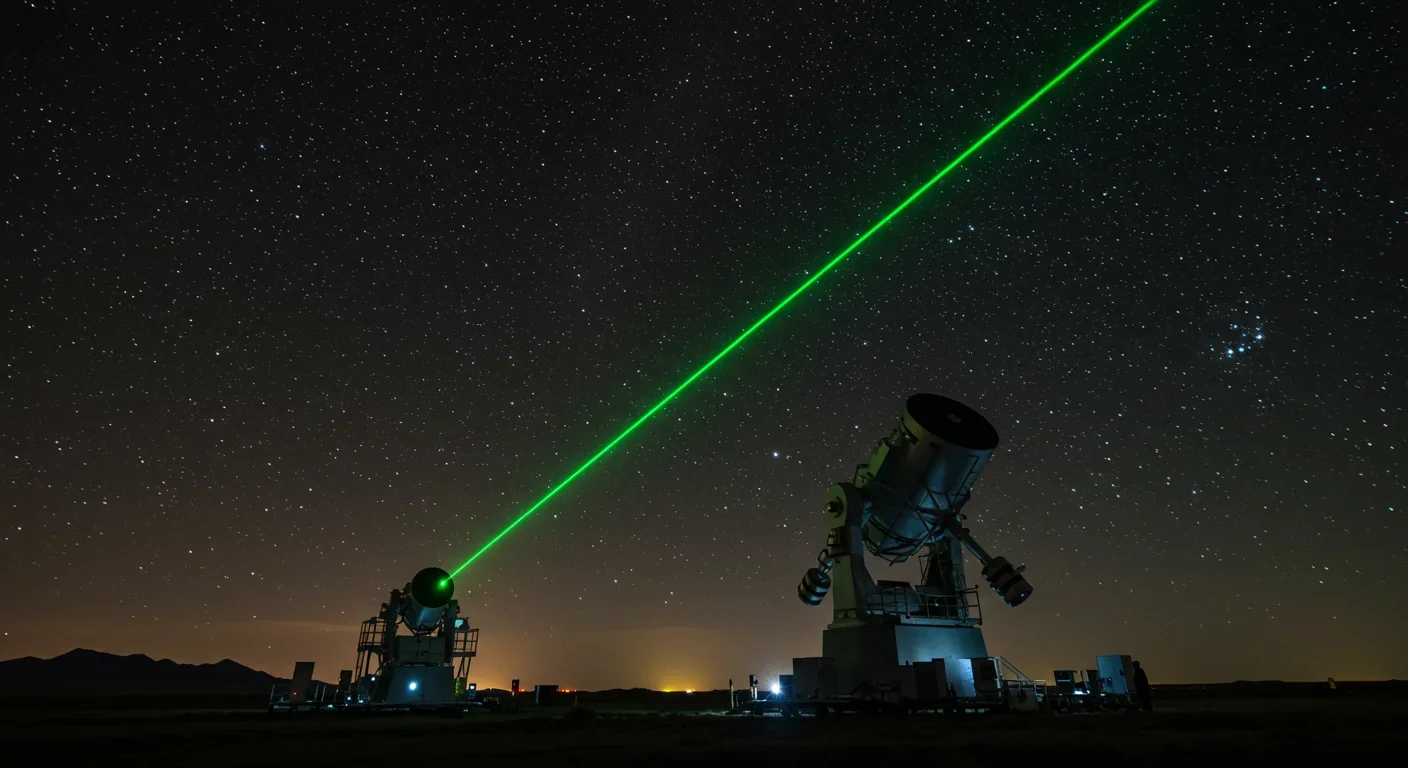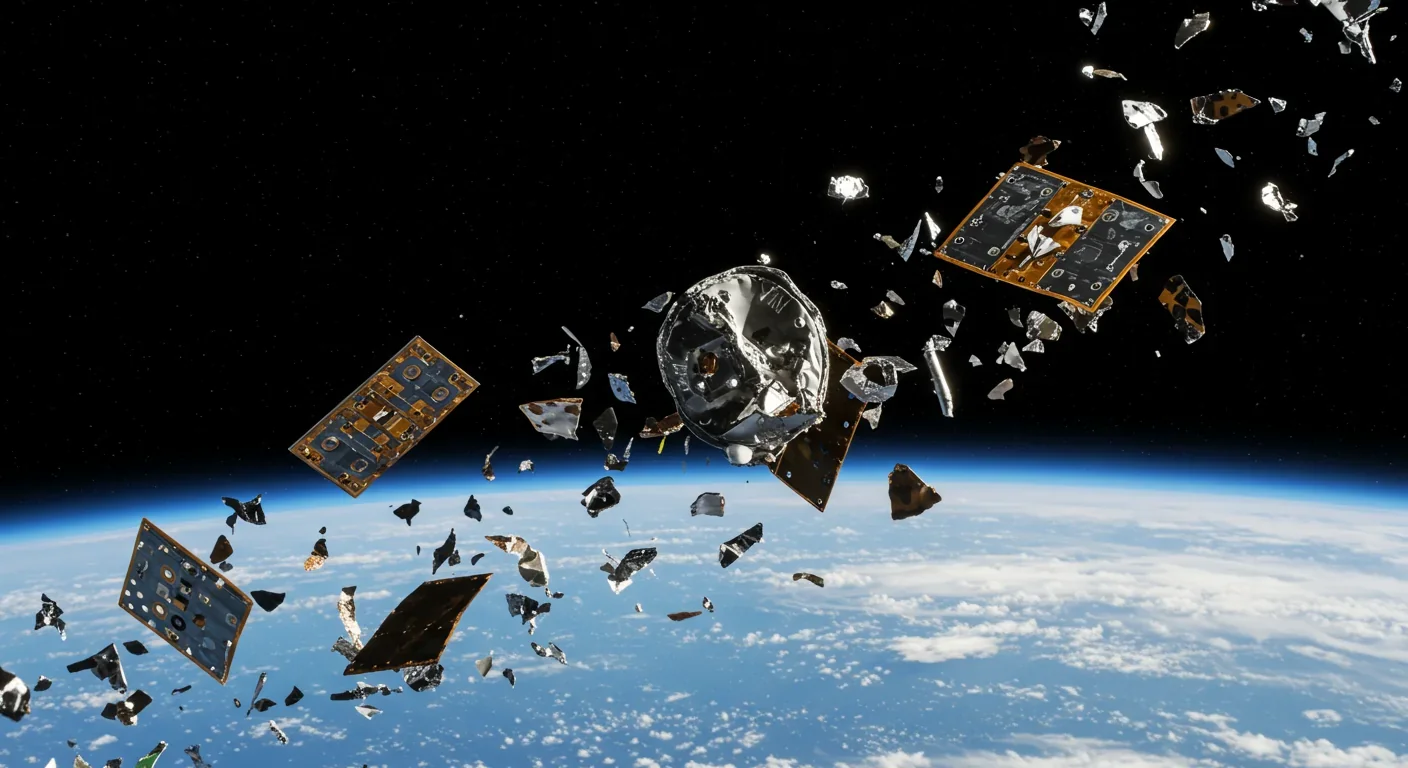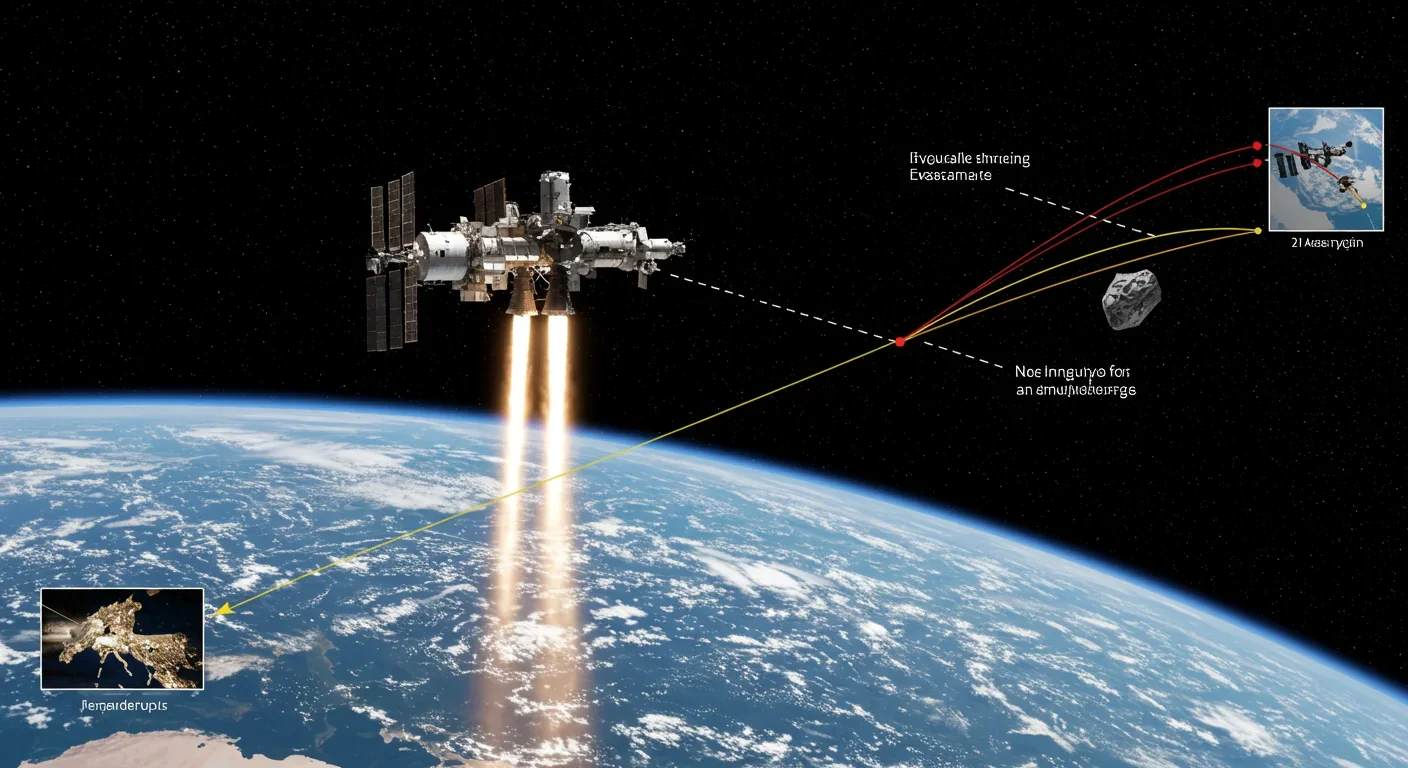The Gravity Heresy: MOND vs Dark Matter Theory Explained

TL;DR: Ground-based laser systems can zap space debris with concentrated light beams, nudging defunct satellites toward controlled reentry before they collide with operational spacecraft. The technology is ready and could begin clearing orbital junk within five years.

By 2030, ground-based laser facilities on mountaintops across three continents will routinely zap defunct satellites, nudging them toward controlled reentry before they collide with the International Space Station. This isn't science fiction anymore. The technology works, the physics checks out, and the first operational systems are being tested right now in Europe and Japan. The only question left is whether we'll deploy them fast enough to prevent the catastrophic cascade that orbital debris experts have been warning about for decades.
Right now, over 27,000 pieces of trackable space debris larger than a softball are screaming around Earth at speeds up to 17,500 mph. That's just what we can see. Millions of smaller fragments, down to paint flecks the size of a grain of sand, create an invisible minefield that threatens every satellite we depend on for GPS, weather forecasting, communications, and climate monitoring.
The International Space Station has dodged potentially hazardous debris 39 times, firing thrusters to move out of harm's way when tracking systems detect incoming objects. Each maneuver costs fuel, shortens the station's operational life, and disrupts experiments. But the real nightmare scenario isn't a single collision, it's the chain reaction that follows.
Scientists call it Kessler Syndrome: one collision creates thousands of new debris fragments, each capable of triggering more collisions in an exponential cascade. Donald Kessler, the NASA scientist who predicted this scenario in 1978, warned that certain orbital zones could become completely unusable for generations. We're closer to that tipping point than most people realize.
The solution sounds deceptively simple: shine a powerful laser at debris to change its trajectory. But the physics behind it represents one of the most elegant applications of light's mechanical properties that science has ever attempted at scale.
When a high-powered laser pulse hits a piece of space junk, it instantly vaporizes a tiny amount of material on the surface, creating a microscopic jet of ablated particles shooting off into space. Newton's third law takes over: that departing cloud of vaporized metal or paint pushes back against the debris, creating thrust. It's like a miniature rocket engine that fires for a fraction of a second.
This process, called laser ablation, doesn't destroy the debris or blow it to smithereens. Instead, it applies precise, calculated nudges that gradually lower the object's orbit. With each laser pulse, the debris drops slightly closer to Earth's upper atmosphere, where increased drag will eventually pull it down to burn up harmlessly during reentry.
The numbers are surprisingly modest. A 1-megajoule pulsed laser can alter the orbit of a 10-centimeter piece of debris enough to deorbit it within weeks, using energy roughly equivalent to what a typical household consumes in a few hours. Scale that up with multiple laser facilities operating continuously, and you're talking about clearing dozens of dangerous objects daily.
The alternative approach uses pure photon pressure, the radiation force that light exerts when it bounces off or is absorbed by a surface. This technique requires less power because you're not vaporizing anything, just pushing with concentrated light the way solar sails use sunlight for propulsion. But it takes longer and works better on lightweight objects with large surface areas, like defunct satellite panels.

The space debris problem exploded literally and figuratively in 2009 when an operational U.S. Iridium communications satellite collided with a defunct Russian Cosmos military satellite over Siberia. The impact created over 2,300 trackable fragments, many of which remain in orbit today, posing ongoing threats to other spacecraft.
That wasn't even the worst debris-creation event. In 2007, China conducted an anti-satellite weapon test, deliberately destroying one of its own weather satellites and generating more than 3,500 pieces of trackable debris. Then in 2021, Russia tested a similar weapon, pulverizing another satellite and forcing astronauts on the ISS to shelter in their docked spacecraft as debris fragments passed nearby.
These intentional destructions highlighted another dimension of the problem: the weaponization of space and the dual-use nature of debris removal technology. A laser powerful enough to deorbit a defunct satellite could theoretically be used to disable an operational one. This reality complicates international cooperation on what should be a shared planetary challenge.
But the threat keeps growing. Every rocket launch adds stages and fairings to the orbital population. Satellite mega-constellations like SpaceX's Starlink are putting thousands of new spacecraft in low Earth orbit, with tens of thousands more planned. Even with deorbiting protocols, failures happen. Dead satellites become debris. And the more objects we put up there, the higher the collision probability climbs.
Europe leads the practical implementation race with two ground-based laser ranging stations now being upgraded specifically for debris tracking. Located on mountaintops in Spain and Greece, these facilities use adaptive optics technology originally developed for astronomy to compensate for atmospheric distortion.
Here's why that matters: Earth's atmosphere is constantly churning with temperature variations, air currents, and moisture that bend and scatter laser beams. Without correction, a laser aimed at a precise point in space would spread out into a useless blob of light by the time it reached orbital altitude. Adaptive optics solves this by measuring the atmospheric distortion in real-time and adjusting the laser beam hundreds of times per second using deformable mirrors.
The same technology that lets ground-based telescopes see distant galaxies with incredible clarity now enables laser systems to focus tightly enough on a 10-centimeter object 500 kilometers overhead to deliver meaningful thrust. It's a perfect example of how fundamental research in one field unlocks applications in completely different domains.
Japan is taking a different approach. Kyoto-based company Shimizu Corporation is developing satellite-mounted laser systems that would operate from orbit itself, eliminating atmospheric interference entirely. The trade-off is power: getting enough energy to a space-based laser means massive solar panels or potentially nuclear power sources, both of which add complexity and cost.
A particularly creative European project called STRATOLASER proposes launching laser systems on stratospheric balloons that float above most of the atmosphere. This middle-ground approach combines some advantages of both ground-based and orbital systems while keeping costs manageable.
The deployment of operational laser debris removal systems will fundamentally change space traffic management from passive tracking to active intervention. For the first time, we'll have the ability to not just watch collisions approach but prevent them.
This shift has profound implications for how we think about orbital sustainability. Currently, satellite operators can only maneuver their own spacecraft. If debris threatens a satellite, the satellite moves, assuming it has fuel and functioning thrusters. But what about the thousands of dead satellites that can't maneuver? Until now, they've just been liabilities drifting through traffic lanes.
Laser systems flip that equation. Instead of moving operational assets out of danger, you move the danger itself. This creates entirely new possibilities for orbital space usage and dramatically extends the operational life of satellites that might otherwise need to carry extra fuel for constant debris avoidance.
Consider the International Space Station, which costs about $150,000 in propellant for each debris avoidance maneuver. Ground-based lasers could handle many of those threats for a fraction of the cost, while also freeing up the station's limited fuel reserves for actual mission requirements rather than defensive positioning.
The technology also enables something impossible with current methods: clearing existing debris that has no propulsion at all. Rocket stages, dead satellites from the 1960s, fragments from accidental collisions, all the accumulated junk of six decades of space activity could finally be addressed systematically rather than just tracked and avoided.

The first operational laser debris removal facility will cost somewhere between $500 million and $1 billion to build and deploy, based on estimates from projects like the 1996 Orion study and current European programs. That sounds expensive until you compare it to alternatives.
Sending robotic spacecraft to physically capture and deorbit debris costs $50-100 million per mission and can only handle one or two large objects before the capture vehicle runs out of fuel. The European Space Agency's ClearSpace-1 mission, planned for 2026, will cost approximately €100 million to remove a single defunct satellite.
Do the math: a ground-based laser facility that can nudge dozens of objects daily operates at orders of magnitude lower cost per debris piece cleared. And unlike capture missions that work for a few months then burn up in the atmosphere, a laser system can operate for decades with just maintenance and occasional upgrades.
The insurance industry is paying attention. Satellite operators currently pay millions in insurance premiums against collision risk. As laser systems become operational, those premiums could drop significantly for satellites in protected orbits, creating direct financial incentives for operators to support debris removal programs.
There's also the replacement cost calculation. A typical communications satellite costs $200-400 million to build and launch. If even one satellite per year is saved from debris collision, laser systems pay for themselves relatively quickly. And we're not talking about one collision per year, we're talking about an accelerating trend that threatens entire orbital zones.
Beyond just preventing catastrophic collisions, operational laser systems open up possibilities that change the economics of space access fundamentally. Clearing debris from high-traffic orbital corridors creates safer, more predictable environments for satellite constellations, space tourism, and eventual orbital manufacturing facilities.
Lower collision risk means satellites can operate with smaller fuel reserves dedicated to debris avoidance, allowing for lighter spacecraft designs or longer operational lives. This compounds over time: each generation of satellites becomes more efficient as the orbital environment improves.
The technology also has applications beyond debris removal. Laser systems designed for nudging junk could be adapted to assist satellites that experience propulsion failures, extending missions that would otherwise be total losses. This kind of orbital assistance infrastructure could become as routine as towing services on highways.
For scientific missions, cleaner orbital zones mean reduced risk to expensive instruments. The James Webb Space Telescope operates at a distant Lagrange point partly to avoid debris-dense regions near Earth. Future space telescopes might be able to operate in closer, more accessible orbits if debris removal systems make those regions safer.
There's even potential for debris mining. Some defunct satellites contain valuable materials like gold, platinum, and rare earth elements used in electronics. If laser systems can efficiently deorbit objects, future facilities might guide high-value debris to recovery zones rather than burning it up, creating a space recycling industry.
For all the promise, serious technical and political obstacles remain. The atmospheric compensation systems work well for large debris in low orbits, but smaller fragments at higher altitudes present much harder targeting problems. A paint fleck at geostationary orbit might be impossible to track precisely enough for laser engagement.
Power requirements scale brutally with distance and debris size. Moving a 1-kilogram object requires far less energy than moving a 1,000-kilogram defunct satellite. The largest pieces of debris, like abandoned rocket stages, might need sustained laser bombardment over weeks to achieve meaningful orbit changes, tying up facilities that could otherwise clear dozens of smaller threats.
Weather creates operational gaps. Ground-based lasers can't shoot through clouds, and many proposed sites have weather patterns that limit clear-sky time. This means you need multiple facilities at different longitudes to ensure continuous coverage, multiplying infrastructure costs.
Then there's the dual-use problem. Any nation developing high-powered space-tracking lasers will face accusations of weaponization from rivals. The same system that removes debris could disable or damage operational satellites if misused. International treaties govern weapons in space, but the line between debris removal and anti-satellite capability is uncomfortably blurry.
Verification becomes crucial. How do you prove your laser facility only targets debris and not functioning satellites? How do you prevent accidents where a system engages the wrong object? These questions require international agreements that don't exist yet, and geopolitical tensions make those negotiations difficult.
There's also the tragedy of the commons aspect. The nations creating the most debris, including the U.S., Russia, and China, aren't necessarily the ones investing most heavily in removal technology. Creating international cost-sharing mechanisms faces the same challenges that plague climate change negotiations.
The space debris problem is genuinely global, threatening all spacefaring nations equally, but responses remain fragmented along national lines. Europe, Japan, and smaller space powers are leading laser development precisely because they have more to lose and less geopolitical interest in space weaponization narratives.
The U.S., with its massive military satellite infrastructure, has been notably cautious about ground-based laser systems despite having the technical capability to build them. The Pentagon's interest in tracking debris doesn't necessarily translate to support for removal systems that other nations could view as weapons platforms.
China operates extensive debris tracking networks but has been secretive about removal technology development, even as it faces criticism for the 2007 ASAT test that created so much debris. Russia's recent anti-satellite tests suggest active debris removal isn't a priority compared to demonstrating space warfare capabilities.
Japan is pushing for international rules on debris removal technology, attempting to establish guidelines before deployment creates facts on the ground, or rather in orbit. This diplomatic approach might be the smartest path forward, but it moves slowly while the debris population grows daily.
The United Nations Committee on the Peaceful Uses of Outer Space has been discussing debris mitigation guidelines for decades, but enforcement mechanisms remain weak. There's no space traffic control authority with the power to compel debris removal or punish nations that create new debris through reckless activities.
The technology is ready. Laser facilities could begin clearing debris within the next three to five years if funding and political will align. The physics works, the targeting systems exist, and the costs are manageable compared to doing nothing.
The most likely scenario is a gradual rollout led by European and Japanese facilities, with operational systems protecting specific high-value orbital corridors first. The ISS orbit would be an obvious early target, given the station's importance and the extensive tracking data already available for threats in that region.
As these systems prove their effectiveness, economic incentives will drive expansion. Satellite operators will lobby for protected orbits. Insurance companies will offer premium discounts. Launch providers will market access to cleaned corridors as a service advantage. Market forces could accomplish what international treaties haven't.
But the window for action is closing. Some orbital debris models suggest we've already passed the point where natural decay exceeds new debris creation in certain altitude bands. Without active removal, those regions could be in permanent Kessler Syndrome regardless of how many new satellites we refrain from launching.
The generation growing up now will either inherit cleaner orbital space or a fragmented junkyard that makes spaceflight prohibitively dangerous. The laser systems being developed today represent our best chance at choosing the former. What we do in the next five years will determine whether space remains accessible for the next fifty.
The stars aren't going anywhere. But our ability to reach them might depend on whether we can clean up the mess we've already made just above our heads.

MOND proposes gravity changes at low accelerations, explaining galaxy rotation without dark matter. While it predicts thousands of galaxies correctly, it struggles with clusters and cosmology, keeping the dark matter debate alive.

Ultrafine pollution particles smaller than 100 nanometers can bypass the blood-brain barrier through the olfactory nerve and bloodstream, depositing in brain tissue where they trigger neuroinflammation linked to dementia and neurological disorders, yet remain completely unregulated by current air quality standards.

CAES stores excess renewable energy by compressing air in underground caverns, then releases it through turbines during peak demand. New advanced adiabatic systems achieve 70%+ efficiency, making this decades-old technology suddenly competitive for long-duration grid storage.

Our brains are hardwired to see patterns in randomness, causing the gambler's fallacy—the mistaken belief that past random events influence future probabilities. This cognitive bias costs people millions in casinos, investments, and daily decisions.

Forests operate as synchronized living systems with molecular clocks that coordinate metabolism from individual cells to entire ecosystems, creating rhythmic patterns that affect global carbon cycles and climate feedback loops.

Generation Z is the first cohort to come of age amid a polycrisis - interconnected global failures spanning climate, economy, democracy, and health. This cascading reality is fundamentally reshaping how young people think, plan their lives, and organize for change.

Zero-trust security eliminates implicit network trust by requiring continuous verification of every access request. Organizations are rapidly adopting this architecture to address cloud computing, remote work, and sophisticated threats that rendered perimeter defenses obsolete.